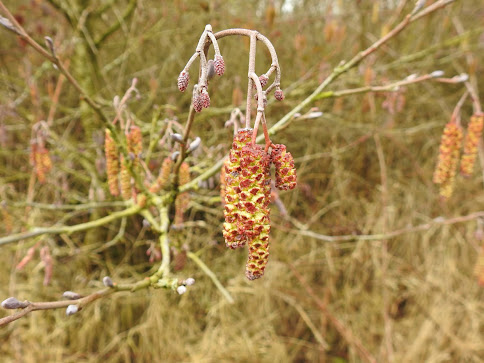The weather has calmed down, but is still a little on the cool side. I was tempted to put my garden moth-trap out, and there will be more of that later. In the meantime I headed to the patch in a further search for spring.
I parked at the church and walked down to the flash field where I was disappointed to find that the Shelducks had gone, and nothing new had arrived. Still, 22 Teal, a drake Wigeon, three Snipe, two Lapwings, 10 Canada Geese, five Greylag Geese, and 12 Mallard were currently in residence.
The remainder of the site needed to step up to the plate, and Stapenhill Wood did just that. I chose to pick my way through the understory now that it is relatively open, and flushed a Woodcock from an impenetrable jungle in the centre of the wood. This was my first this year, although Neil D had one a month ago.
Some time later I was nearing the bee-hives when I spotted a Peregrine heading for the pylons, where it duly landed. Interestingly, it seemed to be soaking wet, so I would guess it had been bathing somewhere. That would have been quite a sight.
 |
| Peregrine |
At the dragonfly ponds all the bulrushes are seeding, and a mat of seeds floating in the largest pond was supporting a female Reed Bunting as it systematically plucked the seeds forming its raft.
 |
| Reed Bunting |
The walk up to the road was enlivened by a flock of about 90 Linnets, which alternated between the hedge and the broad strip before the birch trees.
 |
| Linnets |
Back at the car I finally heard a singing Chiffchaff, and for good measure a singing Blackcap. However the only bird which came close enough for a photo was the classic little brown job, a Dunnock.
 |
| Dunnock |
As it was quite quiet, I found myself photographing plants.
 |
| Blossom |
 |
| Alder catkins |
 |
| Hazel catkins |
The only thing missing was the sun.
Almost missing last night was the moon (it was a new crescent moon). This was all the encouragement I needed to put the trap out, and I was rewarded with a new moth for the garden. I say rewarded, it was actually the moth equivalent of the little brown job, an Agonopterix heracliana, later confirmed by recorder.
 |
| Agonopterix heracliana |
Shortly after releasing it for a nice photo I discovered it is a species that cannot safely be distinguished from its sister species without a good look at the underwing (for which you would need a dead moth). On the other hand its small size pointed to heracliana which is in any case the commoner of the two.
In total I caught 10 moths as follows:

No comments:
Post a Comment